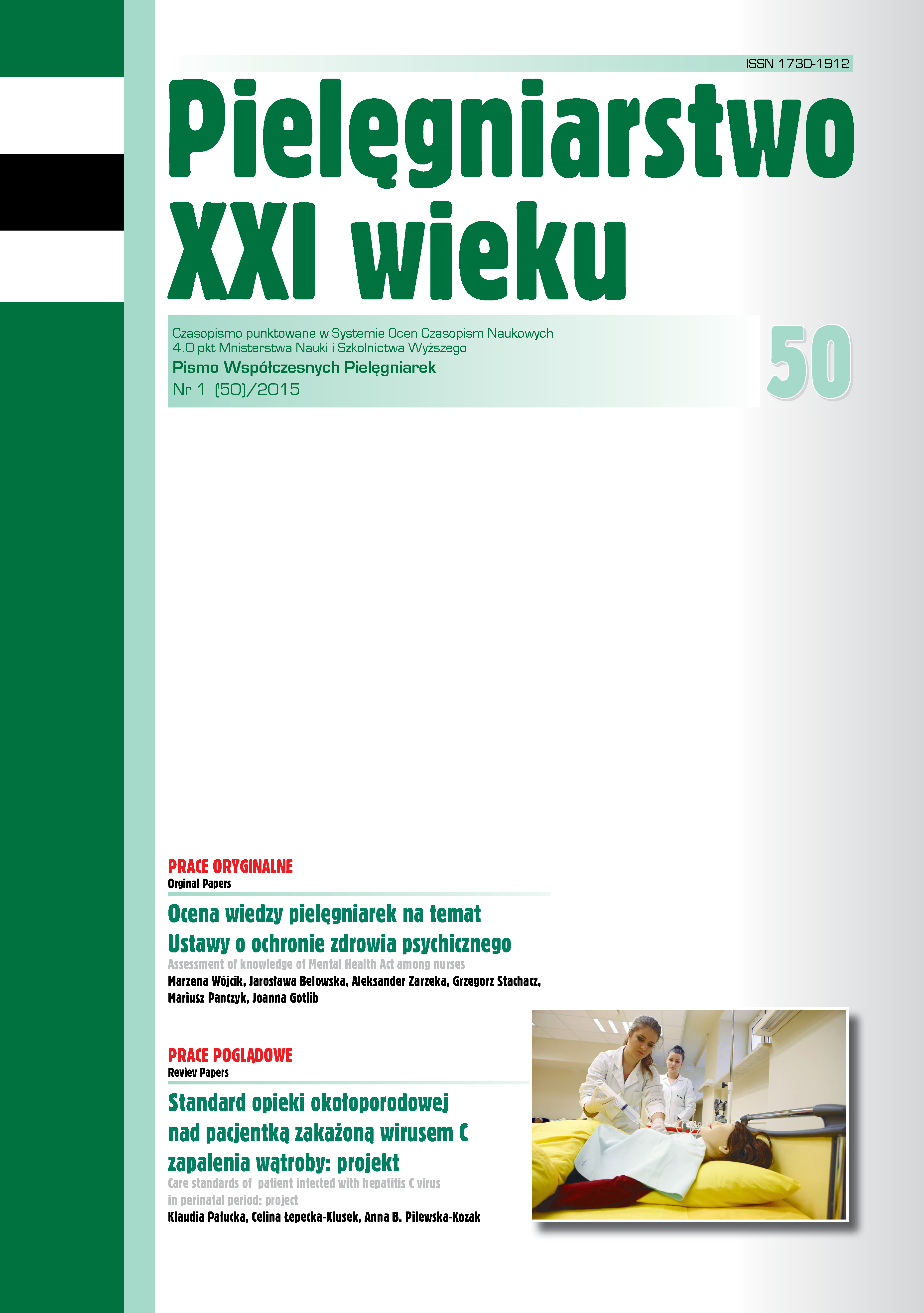Care standards of patient infected with hepatitis C virus in perinatal period: project
DOI:
https://doi.org/10.12923/p21w-2015-1/08Keywords:
hepatitis C virus, perinatal care, standardAbstract
CARE STANDARDS OF PATIENT INFECTED WITH HEPATITIS C VIRUS IN PERINATAL PERIOD: PROJECT
Hepatitis C virus infection is particularly dangerous for pregnant women since it poses danger for both the fetus and newborn. The infection may occur during pregnancy and childbirth. Newborns with congenital infection are exposed to rapid development of the disease. Female newborns are at risk of passing the infection to their children during the reproductive age. This is not a contraindication for planning pregnancy, though. Previous research has shown that there is no link between the virus and the risk of having a baby with birth defects. Being infected with HCV does not increase the risk of health issues in perinatal period. The mode of delivery is still controversial, because of insufficient results stating that caesarean section reduces the risk of vertical infection. The infection is not a contraindication to vaginal delivery. Therefore, it seems appropriate to develop the standards of care for a woman infected with Hepatitis C virus in childbirth and the postpartum period.
References
1. Juszczyk J. Piętnaście lat badań nad wirusem C zapalenia wątroby w Polsce. Przegl Epidemiol. 2005; 59:373-384.
2. Borzęcka B, Błudzin W. Program wczesnego wykrywania zakażenia HCV. Przegl Epidemiol. 2007; 61: 733-738.
3. WHO. Hepatitis C estimated prevalence and number infected by WHO region. Weekly Epidemiological Record.1999;49.
4. Godzik P, Kołakowska A, Madaliński K. Rozpowszechnienie przeciwciał anty-HCV wśród osób dorosłych w Polsce- wyniki badania przekrojowego w populacji ogólnej. Przegl Epidemiol. 2012; 66: 575-580.
5. Kowalska M, Braczkowska B, Zejda JE, i wsp. Ocena częstości i podstawowych uwarunkowań zakażeń wirusem zapalenia wątroby typu C (HCV) wśród studentów wydziałów lekarskich w województwie śląskim. Przegl Epidemiol. 2004; 58: 265-72.
6. Flisiak R, Halota W, Horban A et al. Prevalence and risk factors of HCV infection in Poland. Eur J Gastroenterol Hepatol 2011; 23: 1213.
7. Aniszewska M, Kowalik-Mikołajewska B, Pokorska-Lis M. Częstość występowania przeciwciał anty-HCV u kobiet ciężarnych. Analiza czynników ryzyka zakażenia HCV. Przegl Epidemiol. 2009;63:293-298.
8. Aniszewska M. Dziecko matki zakażonej wirusem zapalenia wątroby. Przew Lek. 2001; 4(3):74-76.
9. Mazza C, Ravaggi A, Rodella A. Prospective study of mother to infant transmission of hepatitis C virus (HCV) infection. Study Group for vertical transmission. J Med Virol. 1998; 54(1): 12-9.
10. The Reproductive Care of Women Living with Hepatitis C Infection. SOGC Clinical Practice Guideline No 96, 2000.
11. Aniszewska M, Kowalik - Mikołajewska B, Pokorska-Śpiewak M i wsp. Badanie przeciwciał anty-HCV jako podstawowy standard monitorowania zakażenia odmatczynego HCV: zalety i wady metody. Przegl Epidemiol.2012;66:341-345.
12. Matyla-Radzewska A, Wysocki C. Przebieg naturalny zakażenia u dzieci oraz transmisja rodzinna wirusa c zapalenia wątroby. Przegl Epidemiol. 2005; 59: 475-481.
Downloads
Published
Issue
Section
License
Copyright (c) 2024 Klaudia Pałucka, Celina Łepecka-Klusek, Anna B. Pilewska-Kozak (Autor)

This work is licensed under a Creative Commons Attribution 4.0 International License.




